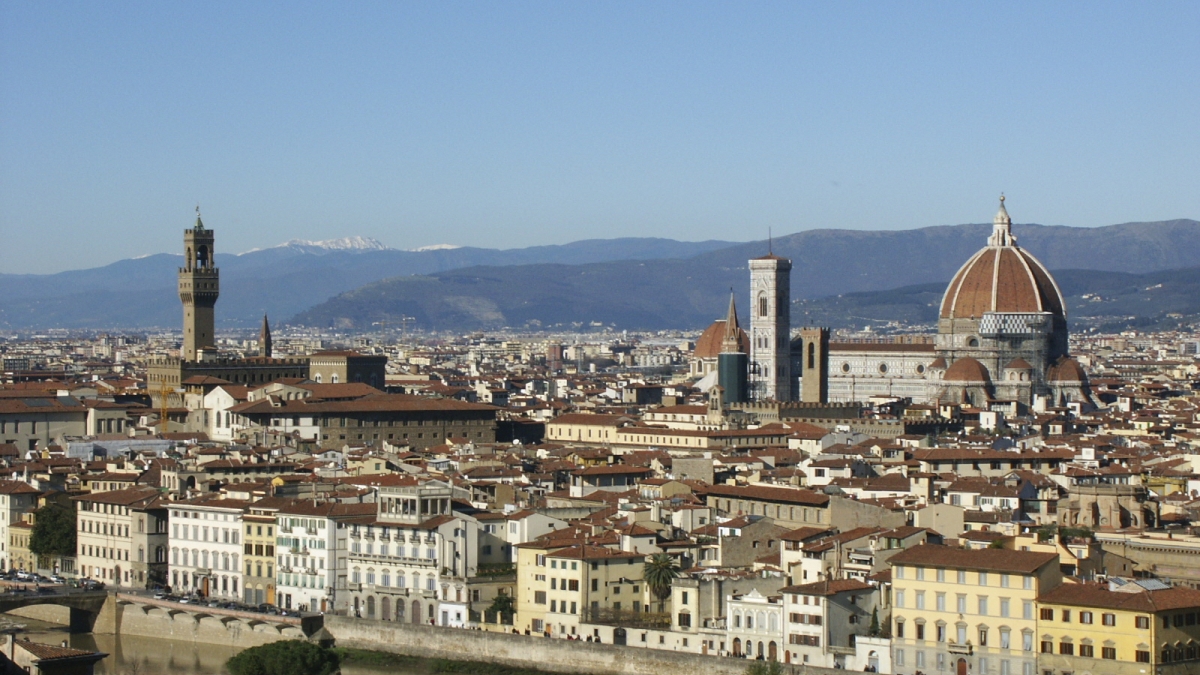International humanities and art focus of Florence, Italy summer program

The School of International Letters and Cultures’ study abroad programs are among the longest running and most prestigious at Arizona State University. Founded in 1981, and directed by knowledgeable, world-class faculty, the programs offer students the opportunity to experience and study international humanities and learn languages firsthand while earning credit toward their degree.
For the 32nd consecutive year, the School is offering students the opportunity to learn about Italian language, art history, and studio art on a faculty-directed summer program in Florence, Italy. The program, which was started by professor of Italian Pier Raimondo Baldini in 1981, is one of the longest running programs at ASU and the single longest running program in the School of International Letters and Cultures, demonstrating its enduring success.
Considered the birthplace of the Renaissance and the Athens of the Middle Ages, Florence has survived a turbulent and intriguing history, which earned its city center the title of UNESCO World Heritage Site in 1982. Besides its vibrant history, the city is also celebrated for its culture, Renaissance art, architecture and monuments. The city, which has grown to a population of 600,000, is situated in central Italy only a few hours by train from such cities as Pisa, Rome, Naples and Milan.
In Florence it is as common to see a work of art as it is to come across a caffè or a gelateria. Whether it is a fifteenth century statue watching over the pedestrians in a piazza, to carvings above a church’s entrance, or one of the hundreds of museums that populate the city, art is everywhere in Florence.
Florence is also home to some of the oldest and most famous art museums in the world, including the Uffizi Gallery, which houses Botticelli’s "The Birth of Venus," Dürer’s "Adoration of the Magi," Leonardo da Vinci’s "The Annunciation," and many other masterpieces of Renaissance art, and the Accademia Gallery, which houses Michelagelo’s "David."
“Studying Renaissance artwork on site,” says two-time program participant Sydney Lines, “provides the utmost opportunity for understanding the art itself. Often times the artwork is still placed in its original (or similar) context, providing greater understanding of the artist's choice of medium, the piece's intended purpose, and its cultural influence. Class is conducted within these contexts--in chapels, piazzas, tombs, museums, etc. The art courses in the program provide an opportunity for one to better participate in the artistic exchange for which a work was created and thus better understand its value and purpose far beyond that which can be experienced from a textbook or a slide in the enclosed space of a lecture hall.”
Students in the Florence Summer Program live together in apartments located among the piazze, cafes, churches, gelaterie, and museums of the city’s historical center. The apartments are equipped with Wi-Fi, air conditioning and kitchen facilities, enabling participants to prepare some of their own meals.
Each student completes seven hours of coursework during the four-week program, broken up into two blocks, with the first block consisting of four-credit Italian language courses in which first-, second-, third-, or fourth-year Italian is offered. The language courses include partner conversation times with Italian students and opportunities to participate in evening Italian-spoken cultural activities throughout the city.
Students then take a second three-credit course in either art history titled "Art of Renaissance Tuscany," which explores how forces outside the artist's studio - like politics, religion, and economics - affected the development of Italian art and architecture in Florence and Tuscany from 1300 to 1600, or a studio art course that allows them to explore a range of media.
"Florence was our classroom," says Cathy Becerra. "It was such a unique experience to not have class held in a room/lecture hall. The material was not only easier to learn, but also made our trip that much more memorable.”
The program’s coursework is supplemented with two in-country excursions. One trip takes students to the medieval hill town of Siena located two hours south of Florence, and famous for its food, art, museums and medieval cityscape. Students tour the historic city center, which has also been declared a UNESCO World Heritage Site.
A second excursion takes students through the vine-covered hills of the Chianti region of Tuscany, famed for its wine and world-renowned Tuscan cuisine.
“I fell in love with the picturesque cities, the passionate people, the vibrant culture, the rich food,” says Morgan Brownlee. “I came home forever changed, and with an unstoppable desire to return to Italy. Expand your mind in ways you never knew were possible. Go to Italy, and fall in love as I did.”
Sydney Lines shares Morgan’s enthusiasm for the program. “Because of my Italian courses in the School of International Letters and Cultures,” she says, “I had the opportunity to climb the scaffolding in Santa Croce and stand within a few feet from the frescoes undergoing restoration. I visited the old residence of the illustrious Brownings, decorated in the same fashion as when they resided there well over a century ago. I gorged myself on a variety of delicious cuisine. I climbed the hills of Florence at sunset to gaze upon the twinkling city from San Miniato al Monte and instantly understood Italy’s seductive power over the cultured mind. There is no reason one should not go to Italy, and if you go once, you are likely to be lured back again and again.”
At the end of the program, students will leave Florence with a profound understanding of the way art and language worked to cultivate cultural identity during the Renaissance.
For more information about the Florence Summer Program, contact faculty director Chiara Dal Martello at chiara.dalmartello@asu.edu.
Applications accepted through the ASU Study Abroad Office.
The School of International Letters and Cultures is an academic unit of the College of Liberal Arts and Sciences.